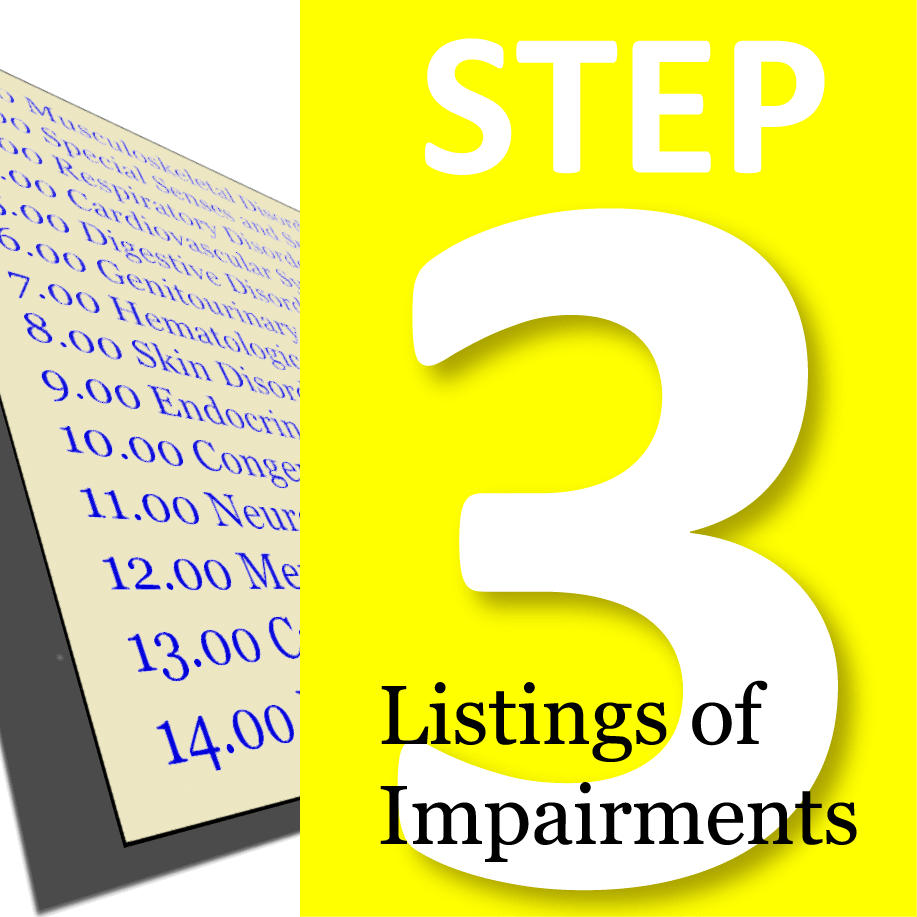Step 3: Listing Level Impairments

Disclaimer: The information below is not legal advice and is intended for informational purposes only. Information on this website may not constitute the most up-to-date legal or other information. Please contact us directly to discuss any specific, particular legal matter.
You may hear people talking about the “Listings of Impairments” or the “Bluebook” when they’re talking about Social Security disability claims. This refers to a long list of impairments a claimant might have. If you meet all of the described criteria in a listing (and the first two steps are resolved in your favor), you’re automatically found disabled and the inquiry ends.
You can find the adult listings here and the child listings here.
But I have a listed impairment. Why haven’t I been found disabled already?
There are a number of reasons you may not have been found disabled even if your condition(s) nominally show up in the listings. First, it’s entirely possible that Social Security made a mistake. Disability determinations are made by human beings at all levels, and people make mistakes. That’s why Social Security has a lengthy appeals process: to try to fix mistakes.
It’s also possible to have a diagnosis that is listed but the specific medical records do not establish a meeting the severity that the listing requires. In any disability case, it’s not enough to be diagnosed with a serious illness or injury. That illness or injury also must interfere with your life to the point that you’re unable to work at all. The listings exist as a shorthand for sets of conditions that, if present, are presumed to stop a person from being able to work. This “shorthand” usually consists of a diagnosis, a set of fairly extreme objective findings, and sometimes some fairly extreme functional effects. Unless all criteria of the listing are present, the listing is not met.
What does it mean to “medically equal” a listing?
Sometimes, you have an impairment that doesn’t quite meet the listed criteria, but it’s every bit as severe as one of the explicitly-spelled-out listings. In other words, the functional effects of the impairment are just as profound as the functional effects of a listed impairment for the same reasons as the listed impairment. In such a case, you can make the argument that your impairment medically equals a listed impairment and you should be found disabled at Step Three just as if your impairment met a listing.
A good example of this is migraine headaches. There is no listing for migraines. However, SSR 19-4p instructs that the closest analogous listing for the condition of migraines is Listing 11.02 for epilepsy, and a medically determinable impairment of migraines may medically equal epilepsy if the severity of the migraines (i.e. the intensity, persistence, and limiting effects) is equivalent to the severity of epilepsy at listing level.
Not many people’s impairments actually meet or equal the severity of a listing. Don’t panic! Step 3 is just the first point in which someone can be found disabled. If a listing is not met, then we have to look to Step 4, which investigates the types of past relevant work an individual has done within the last 15 years, and then Step 5 which considers the practical effect of certain symptoms and behaviors on holding down and maintaining employment at a competitive level. Most successful cases are won at Step 5.

